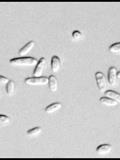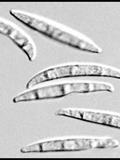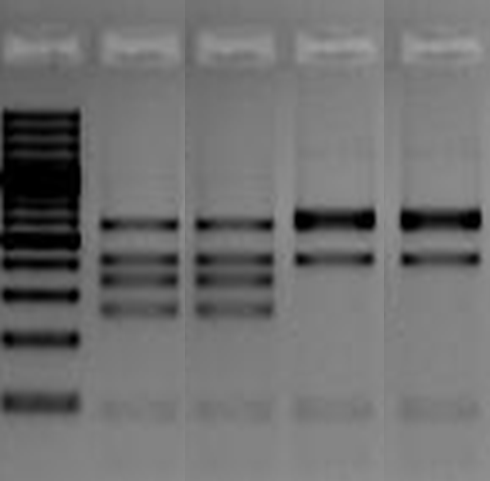External symptoms: Affected plants wilt
rapidly, older and then younger leaves become yellow and brown, and plants
eventually die. Yellowing of the leaves may differ in symptomology between
banana varieties and Foc races involved. In some cases, the base of pseudostems split.
Internal symptoms: Very
typical in rhizome and pseudostem. Internally, a
deep golden discolouration of the inner rhizome develops, while the
vascular bundles in the pseudostem will turn yellow to reddish-brown.
Morphological identification
 Foc produces abundant microconidia that are single celled, oval to kidney-shaped.
Foc produces abundant microconidia that are single celled, oval to kidney-shaped.
 Microconidia are produced in false heads on branched and unbranched monophialide.
Microconidia are produced in false heads on branched and unbranched monophialide.
 Macroconidia are abundant, slighly sickle-shaped with an attenuated apical cell and a foot-shaped basal cell.
Macroconidia are abundant, slighly sickle-shaped with an attenuated apical cell and a foot-shaped basal cell.
 Chlamydospores are present and formed singly or in pairs.
Chlamydospores are present and formed singly or in pairs.
- No perfect stage of F. oxysporum is known.
- On PDA, fungal colonies produce white aerial mycelia that may turn purple in the centre. Isolates may differ in their cultural morphology.
- Cream to orange sporodochia are sometimes formed on carnation leaves on CLA.
Vegetative compatibility groupings
Vegetative compatibility is the ability of hyphae of two individual Fusarium strains to merge (anastomose) to form a heterokaryon. There are 24 known VCGs in Foc (0120-01224), some which form complexes with each other (e.g. VCG 01213/16). VCGs are often used to characterise Foc strains when new outbreaks of Fusarium wilt is reported.
- Puhalla, J.E. 1985. Classification of strains of Fusarium oxysporum on the basis of vegetative compatibility. Canadian Journal of Botany 63: 179-183.
- Leslie, J.F. & Summerell, B.a. 2006. The Fusarium Laboratory Manual, Blackwell Publishing, Ames, Iowa, USA. 388 pp.
Molecular identification
Sequencing of EF region: Comparison with databases:
Use of primer pairs: Developed only for Foc TR4:
- Dita M.A., Waalwijk C., Buddenhagen I.W., Souza Jr M.T. and Kema G.H.J.
2010. A molecular diagnostic for “tropical” race 4 of the banana Fusarium wilt
pathogen. Plant Pathology 59: 348–357.
Li, C.Y., Mostert, G.,
Zuo, C.W., Beukes, I., Yang, Q.S., Sheng, O., Kuang, R.B., Wei, Y.R., Hu, C.H.,
Rose, L., Karangwa, P, Yang, J., Deng, G.M., Liu S.W., Gao, J., Viljoen, A. and
Yi G.J. 2014. Diversity and Distribution of the Banana Wilt Pathogen Fusarium
oxysporum f. sp. cubense in China. Fungal Genomics and Biology 3:
111. doi:10.4172/2165-8056.1000111.
Polymerase Chain
Reaction restriction fragment length polymorphism (PCR-RFLP) of the IGS
region:
- Fourie
G., Steenkamp E.T., Gordon T.R. and Viljoen A. 2009. Evolutionary relationships
among Fusarium oxysporum f. sp.cubense vegetative compatibility
groups, Applied and Environmental Microbiology 75: 4770-4781.


RFLP analysis of Foc strains for separation into lineages AFLP analysis of Foc strains
Detection of Foc
- Best way of detecting disease is early identification of external and internal symptoms.
- Molecular detection of Foc in planting material, water and soil is possible in an experimental laboratory, but not practical in the field, unless targeted detection for the presence of the fungus in specific materials is executed.

